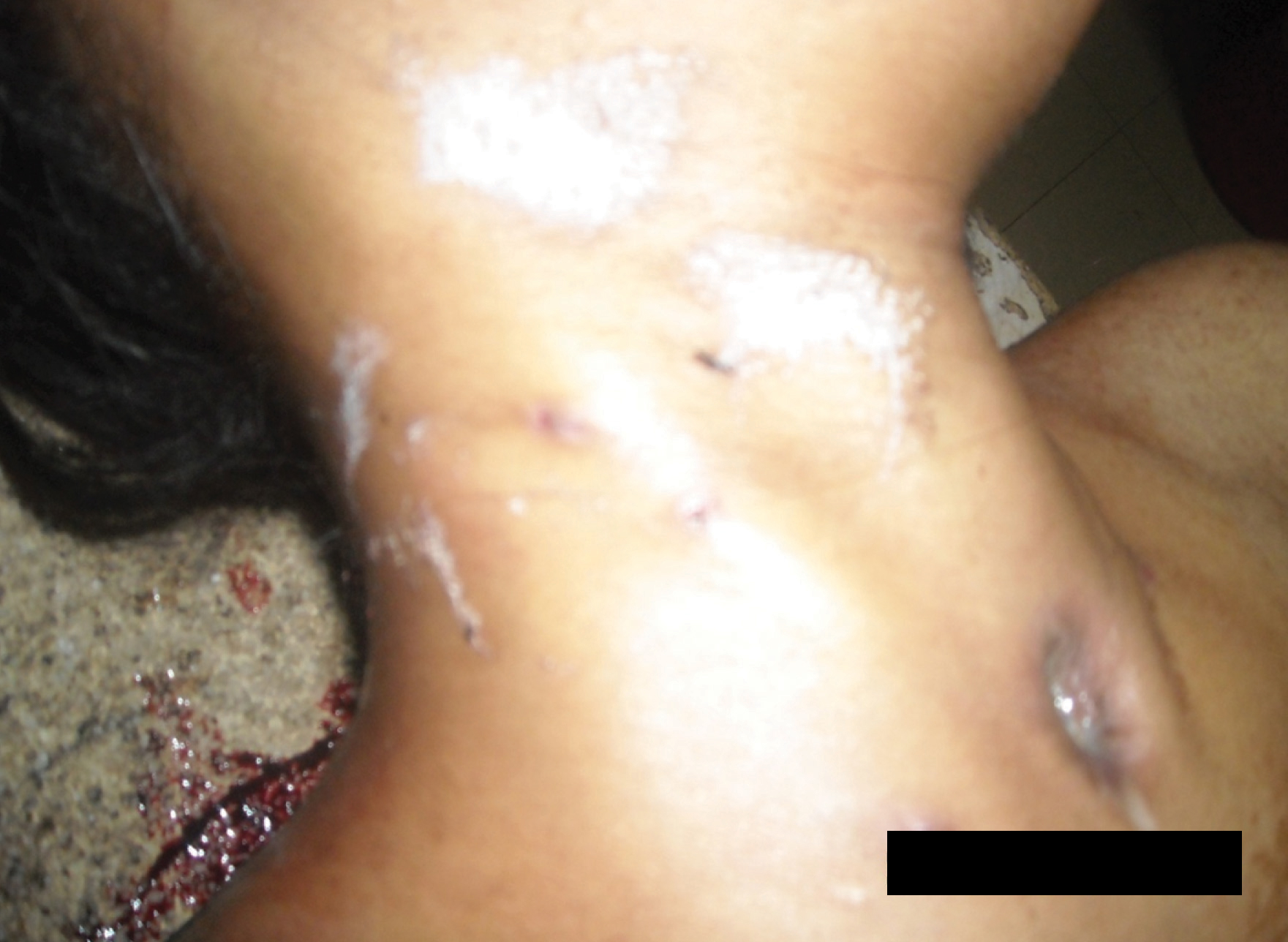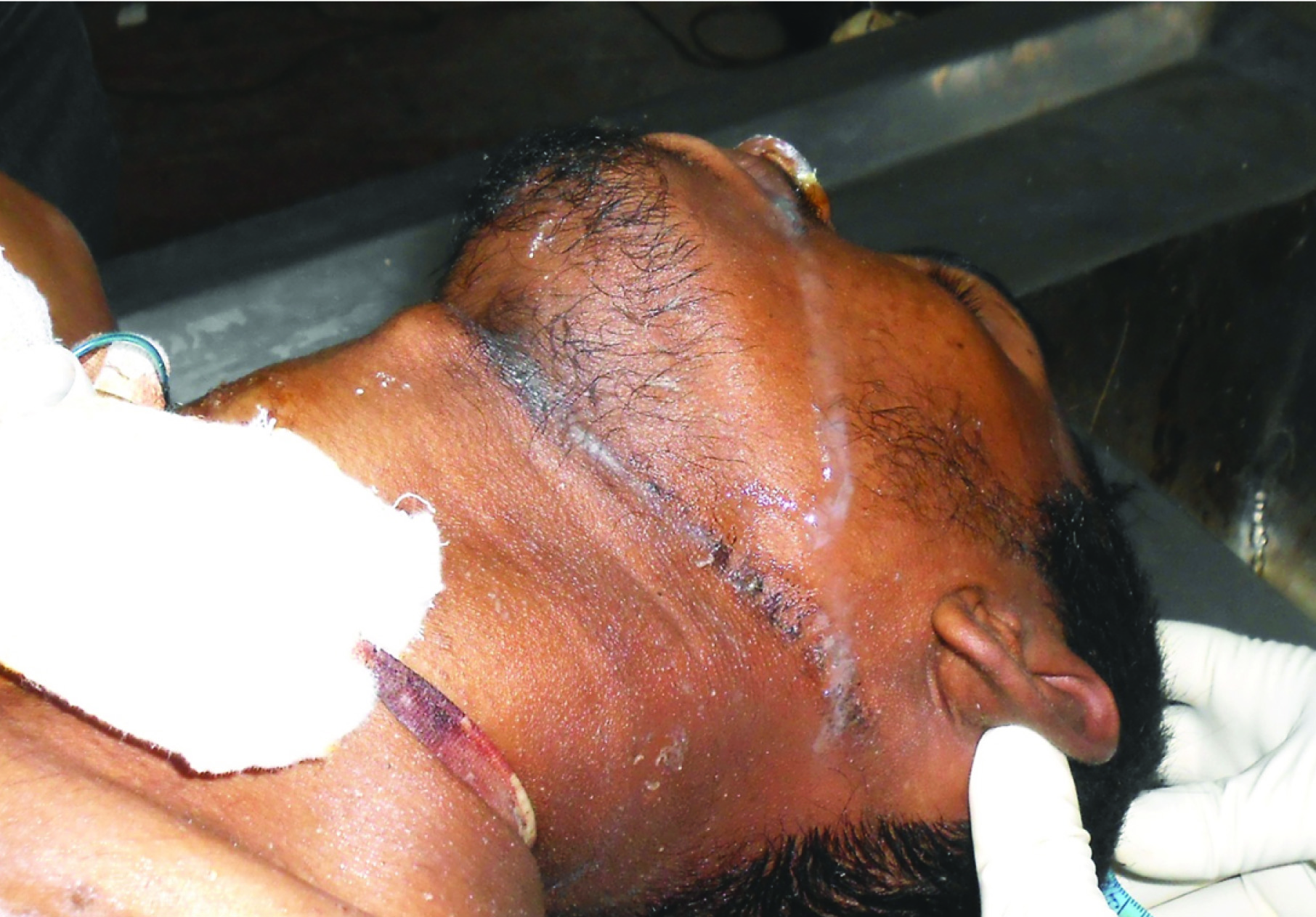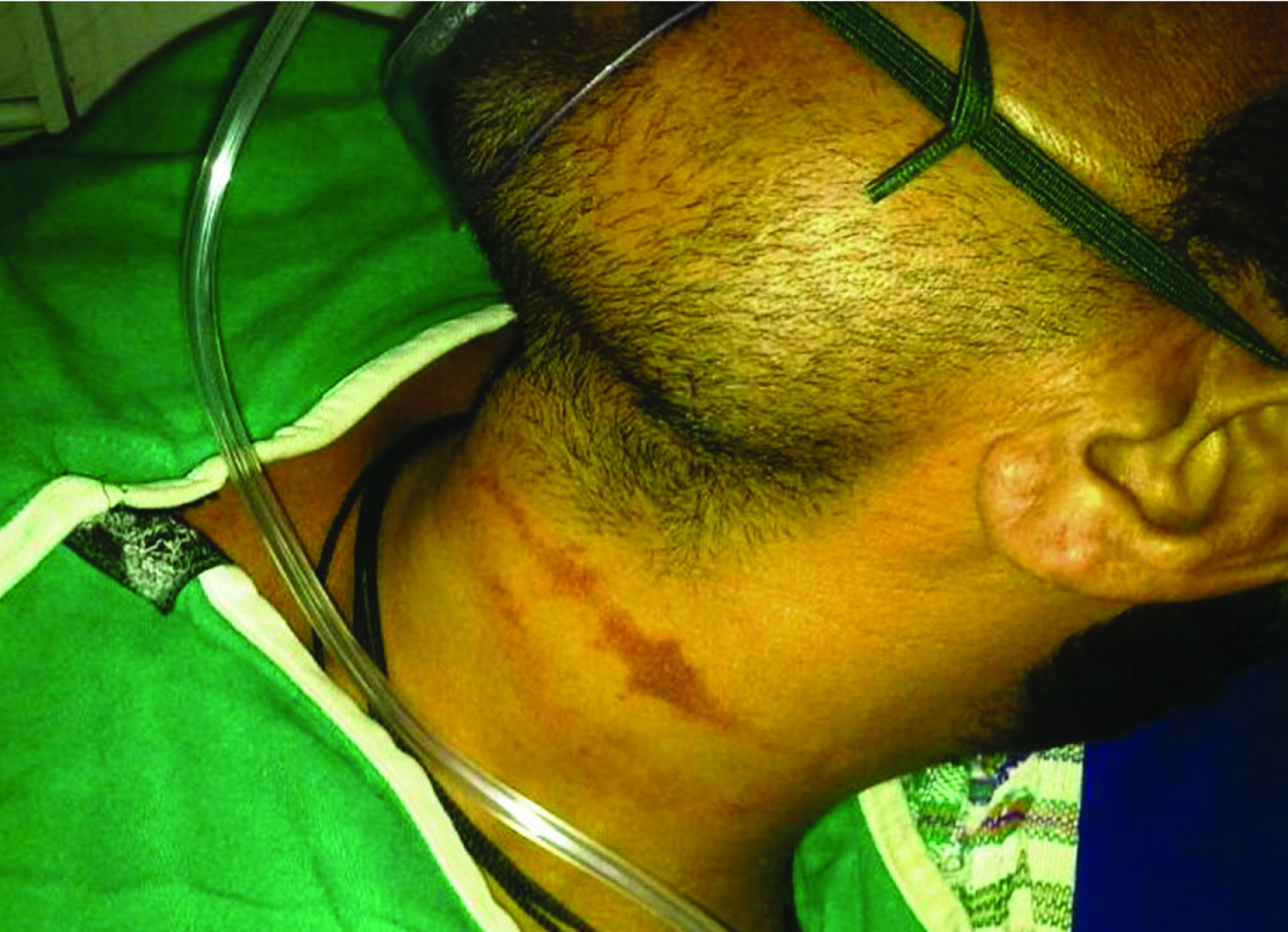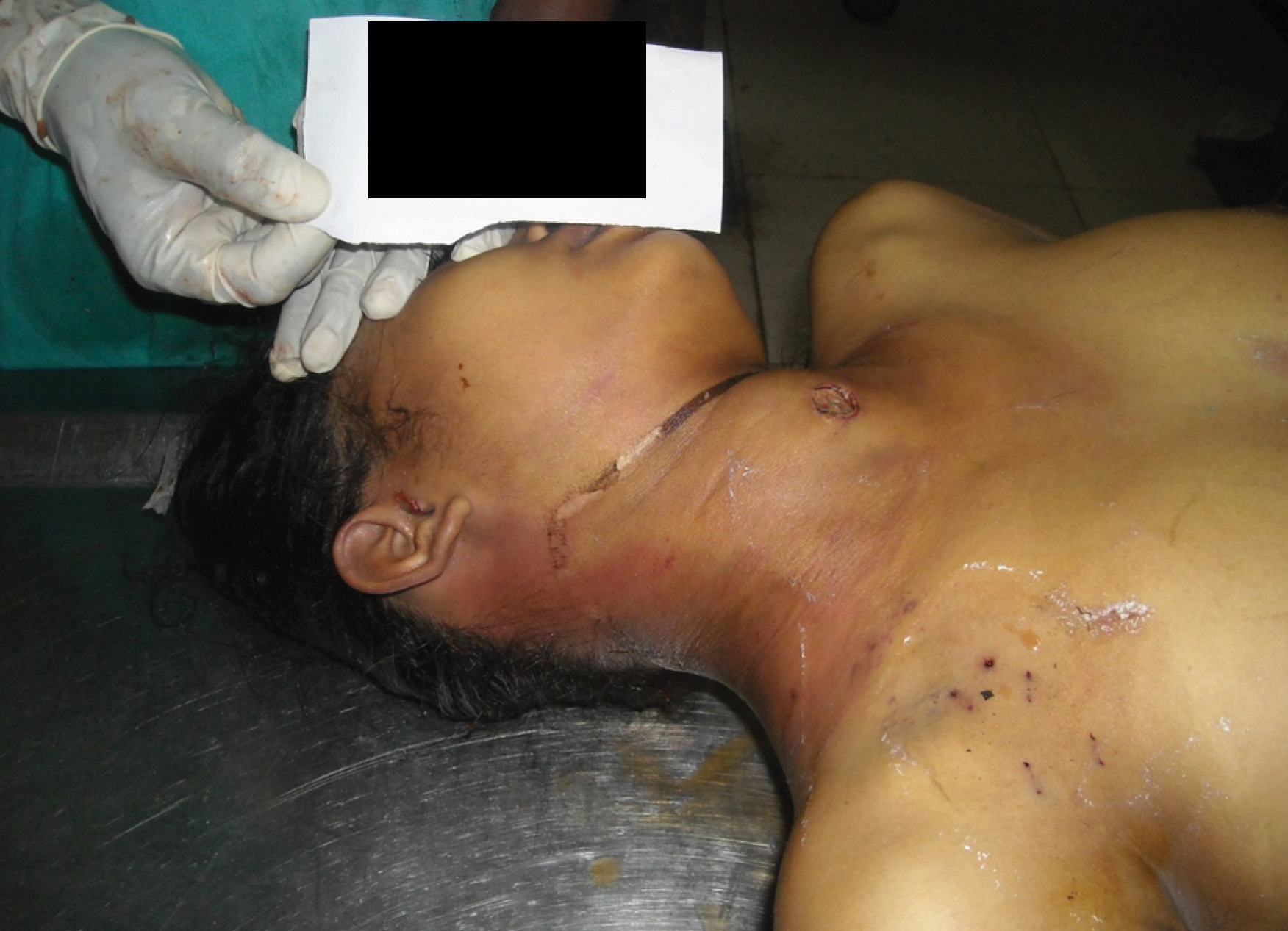Introduction: Near hanging refers to victims who survive a hanging injury following attempted hanging, long enough to reach hospital. Delayed deaths in near hanging patients are mostly due to complication of hanging. The purpose of this study was to evaluate the demographics, mortality patterns and cause of delayed deaths in near hanging victims.
Materials and Methods: In this study autopsy files over a seven year period from 2007 to 2013 were reviewed, and data of near hanging deaths (attempted hanging cases who succumbed to death and subjected for medicolegal autopsy) was extracted. Records of 14,000 autopsies was reviewed, and 10 deceased having died delayed deaths after near hanging episode were identified. In each case, the patients’ details, including gender, age, type of suspension, type of ligature material used for hanging and subsequent hanging mark produced were reviewed using autopsy reports and photographs taken during autopsy.
Results: Demographic and pathological aspects of the each case discussed to throw light on autopsy findings in victims who died following near hanging. Complete suspension was present in 3 cases, while partial suspension was present in 7 cases. Survivals in delayed death after near hanging episode have ranged from 9 h to 72 d. Hypoxic encephalopathy was the most common cause of death, followed by pneumonia.
Conclusion: Most of the near hanging patients did succumb to hypoxic encephalopathy; however, consolidation of lungs (pneumonia) was the next common cause of death reflecting need for aggressive oxygen therapy and selective resuscitation should be performed in all such cases.
Introduction
Hanging is the most common method of suicide in India, constituting 37% cases of suicides in 2012 [1]. Hanging is a form of asphyxial death in which body is suspended by the neck and the constricting force is the weight of the body [2]. Though, ‘Once launched upon suicide by hanging, there is no retreat’, some patients survive a hanging injury long enough to reach the hospital and termed as ‘near hanging’ [3]. Near hanging patients constitute less than 1% of admissions in Intensive Care Unit [4], and constituted only 2.7 % of all reported parasuicides [5]. Delayed deaths in near hanging patients are mostly due to complication of hanging. However, there have been relatively few studies on mortality patterns in patients having delayed deaths due to hanging [6-10]. The purpose of this study was to evaluate the demographics, mortality patterns and cause of delayed deaths in near hanging victims.
Materials and Methods
A multicentric retrospective study was conducted at South western region of India at the Government Medical College, Aurangabad, and, Shri BM Patil Medical College, Bijapur. Autopsy files over a seven year period from 2007 to 2013 were reviewed, and data of Phalke5near hanging deaths was extracted. Records of 14,000 autopsies was reviewed, and 10 deceased having died delayed deaths after near hanging episode were identified. In each case, the patients’ details, including gender, age, type of suspension, type of ligature material used for hanging and subsequent hanging mark produced were reviewed using autopsy reports and photographs taken during autopsy. Clinical course during hospital stay of these patients was reviewed from treatment charts and cause of death was analysed through autopsy files.
Results
The appearance of the ligature mark wound seen in all cases can be briefly summarized as follows. Superficial ‘v’ shaped rising ligature mark was present over neck, discontinuous and showed features of inflammation and healing [Table/Fig-1a,1b,1c,1d] . The data of 10 cases are displayed in [Table/Fig-2] . Hyoid bone fracture, laryngeal/tracheal fracture, pharyngeal laceration, or carotid artery injury was not present in any of the case.
Healing ligature mark with depigmented skin on right lateral aspect of neck (case no 4)

Ligature mark on left lateral aspect of neck, parallel and below the mandible (case no 5)

Healing ligature mark on left lateral aspect of neck (case no 6)

Healing Ligature mark on right lateral aspect of neck and below the mandible (case no 9)

Degree of suspension: In present study, there were 10 delayed deaths due to hanging. Complete suspension was present in 3 cases, while partial suspension was present in 7 cases. Even though rescuers claimed that they brought down victims from suspended position immediately, a recurrent problem with some of these cases is the lack of data concerning the duration of suspension.
Clinical course and period of survival: All cases were unconscious when brought to Emergency Unit of hospital. Ischemic brain damage was diagnosed clinically and radiologically in 7 cases. Case no. 4 was brought in unconscious state, however recovered from initial phase of unconsciousness and went on to survive longest for 72 d. She lapsed in unconsciousness in last 2 days and ultimately died due to septic complication following consolidation of lungs. Case no. 2 had cervical cord injury in form of contusion and oedema, while, case no. 6 had cervical cord injury due to odontoid subluxation. Case no. 7- a case of attempted partial hanging, rescued by relatives and brought to hospital in status epilepticus. Patient died on 4th day with 2pulmonary complications. Case 10 was brought in unconscious state, however recovered from unconscious state and succumbed to aspiration of semisolid food (against medical advice) on 12th day of admission. Resuscitation measures and periods of survival are as mentioned in [Table/Fig-3] .
Cause of death: Hypoxic encephalopathy was major contributor to death accounting for 6 cases. Case no. 3 and 4 succumbed to complication of hypoxic encephalopathy. Respiratory complication was sole cause of death in case no. 9 and 10. Two cases had death due to cervical cord injury. In case no. 7, cause of death was opined as pneumonia associated with hypoxic encephalopathy.
Discussion
Near hanging is a term used to refer to patients who survive a hanging injury long enough to reach hospital, irrespective of its manner, whether it is accidental or suicidal. This term is analogous to “near drowning” that describes victims who survive drowning [4]. Only few persons survive this episode, if rescued promptly and usually die at a later stage, which more precisely can be called delayed hanging death [11]. Regarding period of survival, deaths were delayed ranging from 9 h to 72 d in present study. There is paucity in literature about delayed hanging deaths, only few authors published case reports [6,7,10,11]. Kumar V reported shortest survival period of 15 h in delayed death [11]. Harish et al., reported two cases of delayed death who survived for variable period, i.e. seven and 14 days, cause of death in both cases was cerebral anoxia [8].
Survival in hanging depends upon many factors but it was mainly duration of suspension, early resuscitive measures and force applied for compression of neck [12]. Other factors like point of suspension (around the neck), drop force, totality of hanging (suspension in air or not) [4] and time of releasing the compression around neck [10] may have a bearing on prognosis. State of narcosis and drunkenness as well as extremes of ages, physical infirmity and associated cardio-respiratory ailments will considerably shorten the time period [13]. Incomplete encirclation of neck by ligature and partial hanging was also attributed for minimizing the hypoxic-ischemic damage to the brain [14].
Delayed hanging deaths may occur due to reasons like aspiration pneumonia, infection, hypoxic encephalopathy, oedema of the lungs, oedema of larynx, infarction of the brain, abscess of the brain, cerebral softening [15]. However, hypoxic encephalopathy was the most common cause of death in reported delayed hanging deaths [6-8,10,12]. Hypoxic encephalopathy is a condition in which there is a lack of oxygen supply to the brain, resulting in destructive or degenerative changes [16]. Time required for irreversible cerebral damage to occur is said to be variable, but consensus of opinion is that if the blood supply to brain has been cut off continuously for less than 4-5 min permanent brain damage is very unlikely [17]. Such deprivation oxygenated blood supply may occur because either:
(a) there is occlusion of the arteries in the neck supplying blood to the brain, to which may be added failure to oxygenate the blood due to occlusion of the airway, or,
(b) the cerebral blood flow ceases because the heart stops [18].
In this series, majority (7 cases) suffered hypoxic encephalopathy and its complications before death. No definitive conclusion can be drawn as regards to type of suspension and occurrence of hypoxic encephalopathy, as, 4 cases had partial hanging, and, 3 cases had complete suspension. Analysis of filmed hangings [19], also concluded that type of suspension may not be an important factor in the timing of agonal responses and therefore in the time to irreversible damage and death. Reversed hypoxic encephalopathy was observed in case 4, with initial period of unconsciousness of 20 days. Reported cases [14,16] of reversed hypoxic encephalopathy had uneventful recoveries, with initial period of unconsciousness of 10 h [14].
Consolidation of lungs and cervical cord injury were next common causes of death. Pulmonary complications occurred in 15 of 133 near hanging patients (11%), while cervical spine injury occurred in four of 689 patients (0.6%) [3]. Pulmonary complications include aspiration pneumonia, bronchopneumonia and adult respiratory distress syndrome [14]. Bronchopneumonia was documented by Vaghela DR and Patel PR in delayed hanging death after 36 d [20]. Fatal pulmonary oedema is reported in a patient who succumbed after 6th day [9]. In present study also, consolidation of lungs was noted in four cases. It is stated that after rescue from airway obstruction, reestablishment of patent airway may not provide the proper oxygenation. Pulmonary oedema, in such cases may develop after some delay, however is reversible if recognised and treated properly [21]. Hypoxic encephalopathy associated with impaired respiratory function may have lead to bronchopneumonia. Other, unusual complications documented included hyperthermia, status epilepticus, carotid artery dissection, subarachnoid haemorrhage and pneumoperitoneum [3]. In present series, status epilepticus was observed in a case, which lasted for four days. In a case reported by Wallace D, status epilepticus was provoked by asphyxia which lasted for five hours [22]. According to a case report published by Hausmann and Betz in delayed death four days after an attempted hanging, the individual was conscious and showed no neurological abnormalities. The cause of death was opined as cerebral infarction following a traumatic thrombosis of the subtotally ruptured carotid arteries [23].
Information about findings concerned with delayed hanging deaths
| Case No | Age(Years) | Gender | Type of suspension | Ligature Material | Cause of death |
|---|
| 1. | 30 | M* | Partial | Nylon rope | Hypoxic encephalopathy |
| 2. | 16 | F* | Partial | Cotton rope | Cervical cord contusion |
| 3. | 40 | M | Complete | Nylon rope | Hypoxic encephalopathy with consolidation of lungs |
| 4. | 19 | F | Complete | Cotton rope | Hypoxic encephalopathy with consolidation of lungs |
| 5. | 19 | M | Partial | Cotton rope | Hypoxic encephalopathy |
| 6. | 32 | M | Partial | Lungi# | Hypoxic encephalopathy |
| 7. | 30 | F | Partial | Odani# | Hypoxic encephalopathy with consolidation of lungs |
| 8. | 18 | F | Complete | Odani# | Hypoxic encephalopathy |
| 9. | 17 | F | Partial | Cotton rope | Consolidation of lungs with cervical cord contusion |
| 10. | 41 | M | Partial | Cotton rope | Aspiration pneumonia |
* M: Male; F: Female
#Lungi: Long cotton apparel use to wrap around waist by some Indian Men
Odani: Long apparel use around neck and chest by some Indian Females
Details of resuscitative measures and clinical course
| Case No | Resuscitation measures | Clinical course during hospital stay | Survival Period (days) |
|---|
| 1. | Tracheostomy done | Unconscious | 30 days |
| 2. | Tracheostomy done | Unconscious | 7 days |
| 3. | Tracheostomy done | Unconscious | 4 days |
| 4. | Tracheostomy done | Regained consciousness after 21 days, lapsed into unconsciousness in last 2 days | 72 days |
| 5. | Tracheostomy done | Unconscious | 15 days |
| 6. | No tracheostomy. Ventilatory support since admission | Unconscious | 2 days |
| 7. | No tracheostomy. Ventilatory support since admission | Unconscious. Status epilepticus from admission to death. | 4 days |
| 8. | No tracheostomy | Unconscious | 9 hours |
| 9. | Tracheostomy done Ventilatory support since admission | Unconscious, Quadriplegia and respiratory paralysis due to left lateral subluxation of odontoid process | 7 days |
| 10. | No tracheostomy | Conscious, Quadriplegia | 12 days |
Conclusion
This series represents one of the largest in literature related to delay hanging deaths. Lack of data regarding period between suspension and intial resuscitation is the major limitation of study. Protracted course in delayed death after near hanging episode have ranged from 9 h to 72 d. Most of the near hanging patients did succumb to hypoxic encephalopathy; however, consolidation of lungs (pneumonia) was the next common cause of death reflecting need for aggressive oxygen therapy and selective resuscitation should be performed in all such cases.
Acknowledgements
Authors acknowledge the immense help received from the scholars whose articles are cited and included in references of this manuscript. The authors are also grateful to “Department of Medical Records” of both the institutes for immense help and coordination received while retrieving medical records and autopsy reports.
* M: Male; F: Female
#Lungi: Long cotton apparel use to wrap around waist by some Indian Men
Odani: Long apparel use around neck and chest by some Indian Females
[1]. Crime in India. National Crime Records Bureau. Ministry of Home Affairs. [Internet] 2014 June 15. Retrieved from: http://ncrb.nic.in [Google Scholar]
[2]. TD Dogra, A Rudra, Lyon’s Medical Jurisprudence and Toxicology 2013 11th EditionDelhiDelhi Law House:958 [Google Scholar]
[3]. N Adams, Near hangingEmerg Med 1999 11(1):1-2. [Google Scholar]
[4]. S Karanth, V Nayyar, What Influences Outcome of Patients with Suicidal HangingJAPI 2005 53:853-56. [Google Scholar]
[5]. A Mugadlimath, JP Agarwal, SP Choukimath, N Kuppast, M Sane, SR Hibare, parasuicidesJ Indian Acad Forensic Med 2012 34(3):206-09. [Google Scholar]
[6]. NK Aggarwal, U Kishore, BBL Aggarwal, Hanging-Delayed death (A rare phenomenon)Med Sci Law 2000 40(3):270-72. [Google Scholar]
[7]. SB Bhoi, NK Tumram, DK Shinde, KS Chandekar, Delayed death after attempted suicide by hangingJ Punjab Acad Forensic Med Toxicol 2013 13(2):86-87. [Google Scholar]
[8]. D Harish, A Kumar, BL Sirohiwal, PC Dikshit, Delayed death in hanging: case reportsJ Forensic Med Toxicol 1994 9:48-50. [Google Scholar]
[9]. NB Kumar, CV Tingne, PS Ghormade, AN Keoliya, Delayed death due to fatal pulmonary edema in near hangingJ Forensic Med Sci Law 2014 23(1)[Internet] [Citedon 2014 Sep 22] http://www.mlam.in/pdf/archive/journalofforensicmedicine,scienceandlaw-v23-num1-part-1.pdf [Google Scholar]
[10]. FK Marak, R Balaraman, Delayed death in hangingJ Indian Acad Forensic Med 2008 30(3):149-50. [Google Scholar]
[11]. V Kumar, Delayed Hanging Death : A case reportJ Pak Med Assoc 2007 57(1):39-41. [Google Scholar]
[12]. SK Verma, BBL Agarwal, Accidental hanging with delayed death in a liftMed Sci Law 1999 39(4):342-44. [Google Scholar]
[13]. JB Mukherjee, Violent asphyxial deaths. In: Karmakar RN, editor. Forensic Med. Toxicol 1970 3rd EditionKolkataAcademic Publishers:575 [Google Scholar]
[14]. S Kodikara, Attempted Suicidal Hanging An uncomplicated recoveryAm J Forensic Med Pathol 2012 33(4):317-18. [Google Scholar]
[15]. KSN Reddy, Mechanical Asphyxia. Essentials Forensic Med. Toxicol 2010 3rd EditionHyderabadSuguna Devi:303 [Google Scholar]
[16]. DRM Prasad, SM A state of reversed hypoxic encephalopathy following attempted suicidal hanging : a boonMed Sci Law 2012 52(1):44-46. [Google Scholar]
[17]. P Saukko, B Knight, Fatal pressure on the neck. Kn. Forensic Pathol 2004 3rd EditionLondonArnold:369 [Google Scholar]
[18]. AM Anscombe, BH Knight, Case report. Delayed death after pressure on the neck: possible causal mechanisms and implications for mode of death in manual strangulation discussedForensic Sci Int 1996 78:193-97. [Google Scholar]
[19]. A Sauvageau, R Laharpe, D King, G Dowling, S Andrews, S Kelly, Agonal Sequences in 14 Filmed Hangings With Comments on the Role of the Type of Suspension, Ischemic Habituation , and Ethanol Intoxication on the Timing of Agonal ResponsesAm J Forensic Med Pathol 2011 32(2):104-07. [Google Scholar]
[20]. DR Vaghela, PR Patel, Late death in a case of hanging – A Case Report Anil Aggrawal’s InternetJ. Forensic Med Toxicol. 2003 10(1)[Internet] 2009 [Cited on 2013 Aug 10] Available from: http://www.anilaggrawal.com/ij/vol_010_no_001/main.html [Google Scholar]
[21]. M Kumar, R Mandhyan, U Shukla, A Kumar, RS Rautela, Delayed Pulmonary Oedema Following Attempted Suicidal Hanging – A Case ReportIndian J Anaesth 2009 53(3):355-57. [Google Scholar]
[22]. W Dinsmore, J Crane, ME Callender, Status epilepticus and near hangingPostgrad Med J 1985 61:519-20. [Google Scholar]
[23]. R Hausmann, P Betz, Delayed death after attempted suicide by hangingInt J Leg Med 1997 110(3):164-66. [Google Scholar]